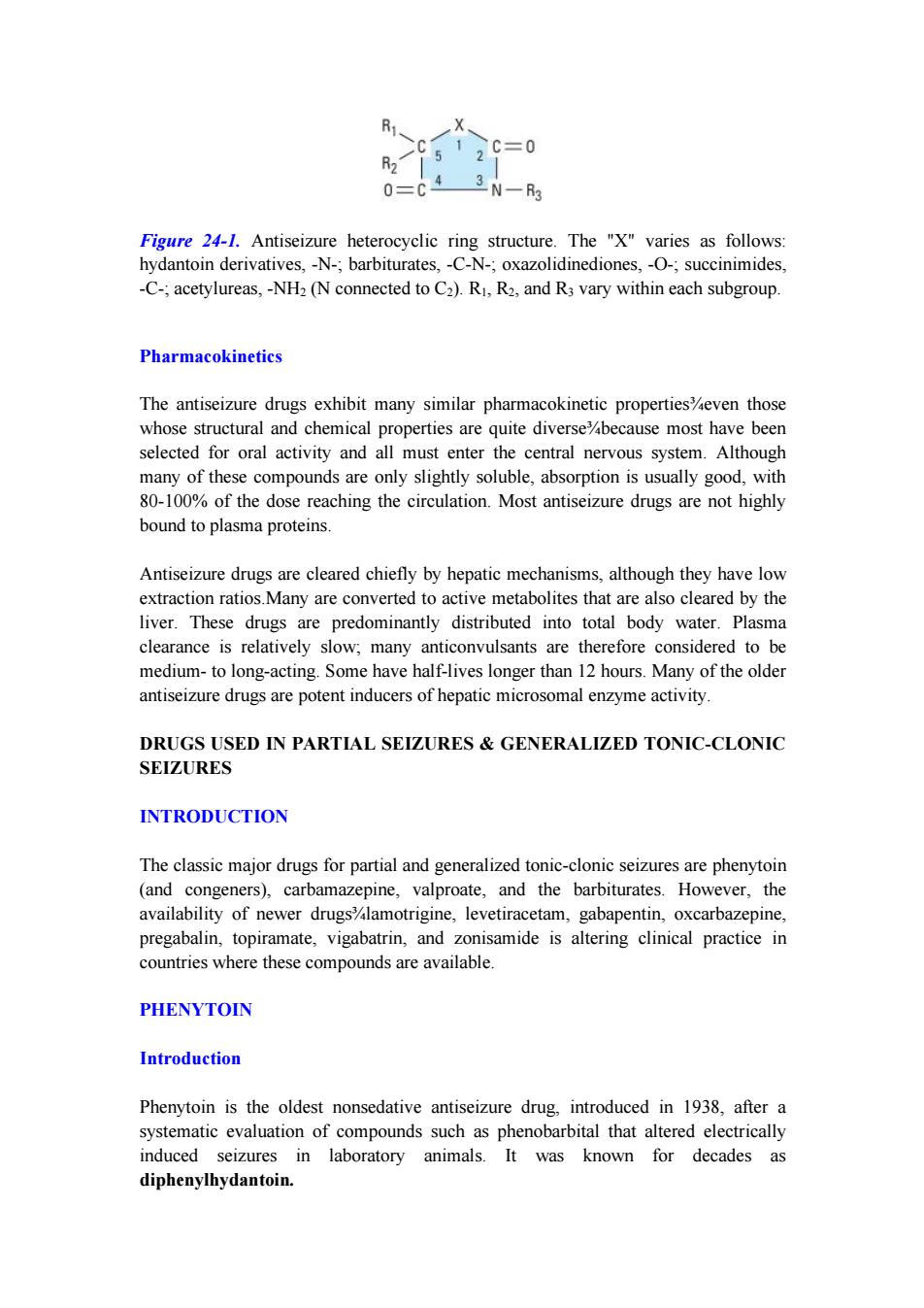正在加载图片...

R 。C=0 0=C 3N一 Figure 24-1.Antiseizure heterocyclic ring structure.The "X"varies as follows: hydantoin derivatives,-N-;barbiturates,-C-N-;oxazolidinediones,-O-;succinimides, -C-;acetylureas,-NH2(N connected to C2).RI,R2,and R3 vary within each subgroup. Pharmacokinetics The antiseizure drugs exhibit many similar pharmacokinetic properties%even those whose structural and chemical properties are quite diverse%because most have been selected for oral activity and all must enter the central nervous system.Although many of these compounds are only slightly soluble,absorption is usually good,with 80-100%of the dose reaching the circulation.Most antiseizure drugs are not highly bound to plasma proteins. Antiseizure drugs are cleared chiefly by hepatic mechanisms,although they have low extraction ratios.Many are converted to active metabolites that are also cleared by the liver.These drugs are predominantly distributed into total body water.Plasma clearance is relatively slow;many anticonvulsants are therefore considered to be medium-to long-acting.Some have half-lives longer than 12 hours.Many of the older antiseizure drugs are potent inducers of hepatic microsomal enzyme activity. DRUGS USED IN PARTIAL SEIZURES GENERALIZED TONIC-CLONIC SEIZURES INTRODUCTION The classic major drugs for partial and generalized tonic-clonic seizures are phenytoin (and congeners),carbamazepine,valproate,and the barbiturates.However,the availability of newer drugs%lamotrigine,levetiracetam,gabapentin,oxcarbazepine, pregabalin,topiramate,vigabatrin,and zonisamide is altering clinical practice in countries where these compounds are available. PHENYTOIN Introduction Phenytoin is the oldest nonsedative antiseizure drug,introduced in 1938,after a systematic evaluation of compounds such as phenobarbital that altered electrically induced seizures in laboratory animals.It was known for decades as diphenylhydantoin.Figure 24-1. Antiseizure heterocyclic ring structure. The "X" varies as follows: hydantoin derivatives, -N-; barbiturates, -C-N-; oxazolidinediones, -O-; succinimides, -C-; acetylureas, -NH2 (N connected to C2). R1, R2, and R3 vary within each subgroup. Pharmacokinetics The antiseizure drugs exhibit many similar pharmacokinetic properties¾even those whose structural and chemical properties are quite diverse¾because most have been selected for oral activity and all must enter the central nervous system. Although many of these compounds are only slightly soluble, absorption is usually good, with 80-100% of the dose reaching the circulation. Most antiseizure drugs are not highly bound to plasma proteins. Antiseizure drugs are cleared chiefly by hepatic mechanisms, although they have low extraction ratios.Many are converted to active metabolites that are also cleared by the liver. These drugs are predominantly distributed into total body water. Plasma clearance is relatively slow; many anticonvulsants are therefore considered to be medium- to long-acting. Some have half-lives longer than 12 hours. Many of the older antiseizure drugs are potent inducers of hepatic microsomal enzyme activity. DRUGS USED IN PARTIAL SEIZURES & GENERALIZED TONIC-CLONIC SEIZURES INTRODUCTION The classic major drugs for partial and generalized tonic-clonic seizures are phenytoin (and congeners), carbamazepine, valproate, and the barbiturates. However, the availability of newer drugs¾lamotrigine, levetiracetam, gabapentin, oxcarbazepine, pregabalin, topiramate, vigabatrin, and zonisamide is altering clinical practice in countries where these compounds are available. PHENYTOIN Introduction Phenytoin is the oldest nonsedative antiseizure drug, introduced in 1938, after a systematic evaluation of compounds such as phenobarbital that altered electrically induced seizures in laboratory animals. It was known for decades as diphenylhydantoin